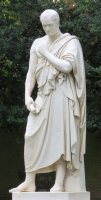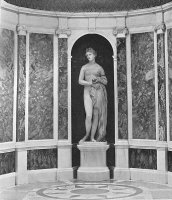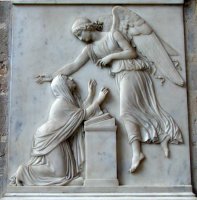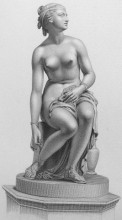John Gibson (1790-1866)
William Huskisson, by John Gibson..
John Gibson was one of the most celebrated 19th Century sculptors. He was born in Wales, spent his young life in Liverpool, and it was from there that he sent his first exhibited works at the Royal Academy, in 1816. But the following year he went to Rome, where after working in the studio first of Canova, and then of Thorwaldsen, he set up on his own account and settled for good. He was elected Associate of the Royal Academy in 1833, and full Academician in 1838, but even so contented himself with the odd rare visit back to England, the last time in 1850, and he died in Rome in 1866 and was buried there. He retained an affection for the Royal Academy, where he had exhibited throughout his career, leaving them a large bequest which allowed for the building of the Diploma Gallery in Burlington House.
Gibson's main oeuvre was Classical, ideal and allegorical. Among his better known works are a Hylas and Psyche borne off by Zephyrs. His bequest to the RA included further sculpture - plaster versions of some of his ideal works, including Narcissus, Venus, Cupid Pursuing Psyche, and best, a Nymph untying Sandal and Sleeping Shepherd Boy. Outside of London, we may note in the Castle Museum, Norwich we may mention a life-sized Meleager (The Hunter).
His most famous ideal work however was the Tinted Venus. He had aroused much comment and interest when he announced that he intended to revive the idea that statues should be coloured, as had been the case in ancient Greece. Alma Tadema showed how this might have looked in his picture of Phidias and the Parthenon Frieze, where the frieze is painted). Gibson's Tinted Venus became instantly famous (at the time, some said notorious) when he departed from the convention of white uncoloured statue and produced this coloured nude statue in 1854. The statue was exhibited at the International Exhibition of 1862, and is now in the collection of the Walker Art Gallery in Liverpool. As described by a contemporary critic:
The colouring is the merest suggestion of delicate tinting; the flesh has the faintest blush of warmth, lending an air of feminine softness to the figure. The eyes have the lightest touch of blue. The hair, plaited and arranged in the graceful and becoming classic fashion, is touched with a pale auburn tinge... the armlet and the apple held in the left hand are gilt, and the earrings are of gold.
The Cornhill Magazine was more fulsome:
First of all, the statue is a marvel of perfection in form. There is no female statue, either of woman or goddess, that is equal to it... Apart from all tinting, we never saw marble imitate so nearly the plump softness of flesh.... Gibson's tinting is more suggestive of life than the plain marble; indeed it is eminently suggestive... [But] if by the tinting he has enhanced the beauty and expression of his statue, that settles the matter; it must be a success.
Originally shown at the 1862 International Exhibition, the statue afterwards went to the Walker Art Gallery in Liverpool where it can be seen today. For all the praise, and converse condemnation for what was seen as a sensuous over-realism, today it seems to the modern viewer just one among the statues in the Walker, and to me, the tinting detracts rather than adds to the splendid figure study.
Aside from the ideal figure studies, Gibson has several portrait statues. In London are two statues by him of Queen Victoria, in the Royal Collection and in the Houses of Parliament, and his too is Robert Peel for Westminster Abbey. Out of doors, a statue of William Huskisson can be seen in Pimlico Gardens, a short walk from Vauxhall Bridge (his monument to Huskisson's wife is in Chichester Cathedral). Also out of London, in Durham Cathedral is Gibson's seated figure of Bishop Van Mildert. Another seated figure by him is George Stephenson, for St George's Hall, Liverpool.
Monument by Gibson with carving in relief.
As a pure Classical sculptor, these portrait sculptures are not dramatic, but in still repose. However, with each visit, I have found myself more impressed; the Huskisson and the Stephenson figures in particular are worth visiting. His ideal figures are really ideal, in a pure, Classical sense, and even where the figures are ostensibly active, for example Cupid pursuing Psyche at the Royal Academy, the sense is of motion arrested rather than motion. Gibson favours an athletic build to his figures, male and female, moderately muscular, and with his females having a solidity and mass rather than slenderness, more Crouching Venus or Aphrodite of Knidos rather than Diana the Huntress. As well as the collections in London and Liverpool, Cardiff has a further group of his female figure sculpture, and here, along with his Nymph and Cupid, Aurora, and Bacchante, we may see a Wounded Amazon who perhaps departs a shade from his favoured type to a more girlish figure, slenderer in the legs and neck if not the arms.
A typical nude by John Gibson: Preparing for the Bath.



